Chaos Control, Codimension-One and Codimension-Two 1 : 2 Strong Resonance Bifurcation Analysis of a Predator-Prey Model with Holling Types I and III Functional Responses
Abstract
We study the existence of fixed points, local stability analysis, bifurcation sets at fixed points, codimension-one and codimension-two bifurcation analysis, and chaos control in a predator-prey model with Holling types I and III functional responses. It is proven that the model has a trivial equilibrium point for all involved parameters but interior and semitrivial equilibrium solutions under certain model parameter conditions. Furthermore, local stability at trivial, semitrivial, and interior equilibria using the theory of linear stability is investigated. We have also explored the bifurcation sets for trivial, semitrivial, and interior equilibria and proved that flip bifurcation occurs at semitrivial equilibrium. Furthermore, it is also proven that Neimark–Sacker bifurcation as well as flip bifurcation occurs at an interior equilibrium solution, and in addition, at the same equilibrium solution, we also studied codimension-two 1 : 2 strong resonance bifurcation. Then, OGY and hybrid control strategies are employed to manage chaos in the model under study, which arises from Neimark–Sacker and flip bifurcations, respectively. We have also examined the preservation of the positive solution of the understudied model. Finally, numerical simulations are given to verify the theoretical results.
1. Introduction
1.1. Motivation and Mathematical Formulation
Remark 1. Discrete-time models are useful for studying different biological systems because they can show how things happen step by step. For example, in population studies, these models help understand the relationships between species, like when animals are born or die. They are also handy in genetics to see how genes change over time. When looking at cells or ecological systems, where events occur at specific times, discrete-time models are a good fit. Even in studying the brain, these models help simulate how neurons work and learn in a way that matches real-life observations. In simple terms, discrete-time models are like a helpful tool for understanding how different parts of nature change and interact.
1.2. Main Contribution
- (i)
Local behavior for fixed points.
- (ii)
Identification of bifurcation sets for fixed points.
- (iii)
Analysis of codimension-one and codimension-two bifurcations in the discrete model (7).
- (iv)
Study of chaos by OGY and hybrid control strategies.
- (v)
Confirmation of theoretical results numerically.
- (vi)
Preservation of the positivity.
The remainder of the paper is organized as follows: Stability analysis and codimension-one bifurcation sets are discussed in Section 2 whereas codimension-one bifurcation at fixed points of the discrete model (7) is studied in Section 3. The codimension-two 1 : 2 strong resonance bifurcation analysis is studied in Section 4. The chaos control by OGY and Hybrid control strategies is presented in Section 5. To validate theoretical findings, numerical simulations are presented in Section 6. Section 7 is about the preservation of the positivity whereas future work and conclusion are given in Section 8.
2. Codimension-One Bifurcation Sets and Stability Analysis
Theorem 2. φ1 of model (7) is a
- (i)
sink if 0 < c < 1 and 0 < a < 1;
- (ii)
never source;
- (iii)
saddle if 0 < c < 1 and a > 1;
- (iv)
nonhyperbolic if a = 1.
Remark 3. Biologically, φ1 is a sink implying that predator and prey vanish, and so this case is irrelevant biologically.
Now, it is important here to note that φ1 is nonhyperbolic if a = 1. So, if a = 1 holds, then but . Finally, linked to Theorem 2, there emerges the subsequent theorem concerning the fold bifurcation set.
Theorem 4. For φ1, the fold bifurcation set is .
Theorem 5. φ2 is
- (i)
a sink if 1 < a < 3 and (bτ/(2 − c + bτ)) < a < (bτ/(bτ − c));
- (ii)
a source if a > 3 and a > (bτ/(2 − c + bτ));
- (iii)
a saddle if a > 3 and (bτ/(2 − c + bτ)) < a < (bτ/(bτ − c));
- (iv)
nonhyperbolic if a = 3 or a = (bτ/(2 − c + bτ)).
Remark 6. Biologically, it is worth noting that the stability of φ2 indicates that φ1 is unstable, which implies the presence of prey and the extinction of the predator.
It is important here to note that if φ2 is nonhyperbolic, then flip bifurcations may take place. In a more exact sense, if a = 3 holds, then but . Finally, linked to Theorem 4, there emerges the subsequent theorem concerning the flip bifurcation set.
Theorem 7. For the model’s semitrivial fixed point φ2, the flip bifurcation set is .
Theorem 8. If Δ < 0, then φ3 is a
- (i)
stable focus if a < (b3eτ3(c − 1) + bc2τ(c + 1)/b3eτ3(c − 1) − b2c2eτ2 + bc2τ(c + 1) − c3(2 + c)) with e > max{(c2(c + 1)/b2τ2(1 − c)), (c2(c(2 + c) − bτ(c + 1))/b2τ2(bτ(c − 1) − c2))};
- (ii)
unstable focus if a > (b3eτ3(c − 1) + bc2τ(c + 1)/b3eτ3(c − 1) − b2c2eτ2 + bc2τ(c + 1) − c3(2 + c));
- (iii)
nonhyperbolic if a = (b3eτ3(c − 1) + bc2τ(c + 1)/b3eτ3(c − 1) − b2c2eτ2 + bc2τ(c + 1) − c3(2 + c)).
Theorem 9. If Δ ≥ 0, then φ3 is a
- (i)
stable node if bτ/(bτ − c) < a < (b3eτ3(c − 6) + bc2τ(c − 2)/b3eτ3(c − 2) − b2c2eτ2 + bc2τ(c + 2) − c3(4 + c)) with b > (c/τ) and e > max{(c2(2 − c)/b2c2(c − 6)), (c2(c(4 + c) − bτ(c + 2))/b2τ2(bτ(c − 2) − c2))};
- (ii)
an unstable node if a > (b3eτ3(c − 6) + bc2τ(c − 2)/b3eτ3(c − 2) − b2c2eτ2 + bc2τ(c + 2) − c3(4 + c));
- (iii)
nonhyperbolic if a = (b3eτ3(c − 6) + bc2τ(c − 2)/b3eτ3(c − 2) − b2c2eτ2 + bc2τ(c + 2) − c3(4 + c)).
It is important here to note that if a = (b3eτ3(c − 1) + bc2τ(c + 1)/b3eτ3(c − 1) − b2c2eτ2 + bc2τ(c + 1) − c3(2 + c)) holds, then evaluated at φ3 has complex eigenvalues with . On the other hand, if a = (b3eτ3(c − 6) + bc2τ(c − 2)/b3eτ3(c − 2) − b2c2eτ2 + bc2τ(c + 2) − c3(4 + c)) holds, then but . Finally, linked to Theorems 8 and 9, we have the following.
Theorem 10. For the model’s interior equilibrium point φ3, the Neimark–sacker and flip bifurcation sets, respectively, are
- (i)
;
- (ii)
.
3. Codimension-One Bifurcations
3.1. Analysis of a Flip Bifurcation for the Semitrivial Fixed Point
From (27)–(29), one can conclude that the flip bifurcation takes place. Based on the analysis, one has the following.
Theorem 11. Flip bifurcation takes place in (7) if .
3.2. Analysis of a Neimark–Sacker Bifurcation for the Interior Fixed Point
Consequently, one can deduce the following outcome.
Theorem 12. When the parameters (a, d, e, b, τ, c) are restricted to and the condition is satisfied based on (39), a Neimark–Sacker bifurcation occurs. Furthermore, a supercritical (subcritical) Neimark–Sacker bifurcation occurs when .
3.3. Analysis of a Flip Bifurcation for the Interior Fixed Point
Consequently, from above calculation, one has the following theorem.
Theorem 13. If the parameters and , then at φ3 flip bifurcation takes place. Besides, the period-2 points bifurcate from φ3 of model (7) are stable (unstable) if .
4. Codimension-Two 1 : 2 Strong Resonance Bifurcation Set and Its Analysis
Based on above analysis, one has the following result.
Theorem 14. If and C ≠ 0, D + 3C ≠ 0, then at φ3, model (7) undergoes 1 : 2 strong resonance bifurcation. In addition, φ3 is saddle (respectively, elliptic) if C < 0 (respectively, C > 0), and in the neighborhood of 1 : 2, point D + 3C ≠ 0 designates the following curves:
- (i)
Pitchfork bifurcation curve:
(87) - (ii)
Heteroclinic bifurcation curve:
(88) - (iii)
Homologous bifurcation curve:
(89) - (iv)
Nondegenerate N-S bifurcation curve:
(90)
5. Chaos Control
In the present section, we will apply the following two feedback control strategies to model (7) to get a stable trajectory:
5.1. By OGY Method
Then, stable eigenvalues lie within the triangular region (k1k2)-plane bounded by the straight lines L1,2,3 for parametric values a, b, c, d, e, and τ.
Remark 15. In the context of a discrete prey-predator model, feedback gains k1 and k2 play a crucial role in controlling the system’s dynamics using the OGY method. These feedback gains are typically parameters that determine the strength and nature of the feedback loop regulating the interactions between the predator and prey populations. More specially, k1 represents the influence of the predator population on the prey population dynamics. A higher value of k1 implies stronger regulation of the prey population growth by predation. In biological terms, this could correspond to factors such as predation pressure or the efficiency of predators in hunting prey. For instance, if k1 is high, it suggests that predators have a significant impact on controlling prey population growth, reflecting a scenario where predation is a dominant factor in shaping prey dynamics. On the other hand, k2 reflects the influence of the prey population on the predator population dynamics. A higher value of k2 implies stronger regulation of predator population growth by prey availability. In biological terms, this could represent factors such as prey abundance or the efficiency of predators in capturing prey. If k2 is high, it suggests that prey availability strongly influences predator population dynamics, indicating a scenario where prey abundance is a key determinant of predator population size.
5.2. By Hybrid Control Feedback
So, based on the stability theory, one has the result.
Lemma 16. Equilibrium φ3 of model (105) is a sink iff |2 + α(a − 1 − (2ac/bτ) − (2beτ(bτ(a − 1) − ac)/c2 + b2eτ2))| < 2 + α(a − 1 − (2ac/bτ) − (2beτ(bτ(a − 1) − ac)/c2 + b2eτ2)) + (α2c(bτ(a − 1) − ac)/bτ) < 2.
Remark 17. In the context of real ecosystems and considering current ecological knowledge, chaos control emerges as a crucial concept when addressing disruptions such as Neimark–Sacker and flip bifurcations. These disruptions, reflecting our awareness of the complex and nonlinear nature of ecological systems, can introduce chaotic dynamics, same as unpredictable fluctuations in predator and prey interactions. Chaos control strategies, informed by contemporary ecological insights, play a pivotal role in mitigating the impact of these disruptions. By understanding the factors that lead to chaotic behavior, ecologists can implement control measures to guide the system back to a stable and predictable state. This might involve adjusting key ecological parameters, introducing adaptive management practices, or leveraging technological advancements to intervene in the ecosystem’s dynamics. In the application of chaos control within real ecosystems, the goal is not only to prevent ecological chaos but also to enhance the overall resilience and sustainability of the system. Harnessing current ecological knowledge, scientists strive to develop and implement effective chaos control strategies that contribute to the preservation of biodiversity, the stability of populations, and the health of ecosystems. In this way, chaos control becomes an integral component of ecological management, aligning with our evolving understanding of the intricate relationships within natural systems. In short, when real ecosystems face disruptions such as N-S and flip bifurcations, scientists use chaos control strategies, guided by what we know about nature. It is like fixing a dance that has gone a bit wild. By understanding and managing these disruptions, we aim to bring stability back to the way animals interact in nature. This helps keep the environment healthy and ensures that both nature and the communities relying on it can thrive together. Our growing knowledge of ecology acts as a guide, leading us to more effective ways of maintaining a balanced and sustainable relationship between different species.
6. Numerical Simulations
In this section, we will present some simulation for the correctness of theoretical results. All plots have been drawn by Mathematica and MATLAB software.
Example 1. If d = 0.4, c = 0.9, b = 0.8, e = 0.09, τ = 4.9, and a = [0.1, 2.99] with (x0, y0) = (0.03, 0.4), then N-S bifurcation exist for model (7) at a = 2.433366930993503. The Maximum Lyapunov exponent with bifurcation diagrams are drawn in Figure 1. In addition, at (c, b, d, e, τ, a) = (0.8, 0.9, 0.4, 0.09, 4.9, 2.433366930993503), model (7) has interior equilibrium point φ3 = (0.22959183673469383, 1.3592438014406019) and moreover, from (19), one gets
The roots of (110) are λ1,2 = 0.6063914134642423 ± 0.7951663056724918ι with |λ1,2| = 1, and so from (i) of Theorem 10, one gets . Furthermore, if we fixed c = 0.9, b = 0.8, d = 0.4, e = 0.09, and τ = 4.9 and varying a < 2.433366930993503, that is, a = 2.38877, a = 2.39999, 2.40099, 2.41999, 2.42444, 2.43119 < 2.433366930993503, then Figures 2(a), 2(b), 2(c), 2(d), 2(e), and 2(f) clearly indicate that respective equilibria is stable focus. On contrary, we get the unstable focus if a > 2.433366930993503, and in addition, as a result, supercritical N-S bifurcation takes place. For example, if b = 0.8, c = 0.9, d = 0.4, e = 0.09, and τ = 4.9, then from (32), one gets holds, and moreover, if a = 2.433366930993503, then from (134) and (135), one gets
Utilizing (111) and (112) into (135), one gets
Now in view of (41) and (113), one obtains
Now, using (114) with into (39), we get . This indicates that closed invariant curve appears, and at φ3 = (0.22959183673469383, 1.3592438014406019), supercritical N-S bifurcation exists (see Figure 3(a)). Same behavior exists for the discrete model (7) at respective fixed points if a = 2.43999, 2.44999, 2.45641, 2.46999, 2.49999, 2.50999, 2.52111, and 2.53000 > 2.433366930993503 (see Figures 3(a), 3(b), 3(c), 3(d), 3(e), 3(f), 3(g), 3(h), and 3(i)). Therefore, in conclusion, we can say that numerical simulations in Example 1 agree with theoretical results obtained in Theorem 8(i) of Theorems 10 and 12.
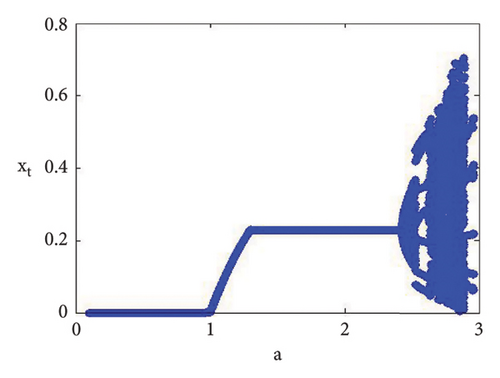
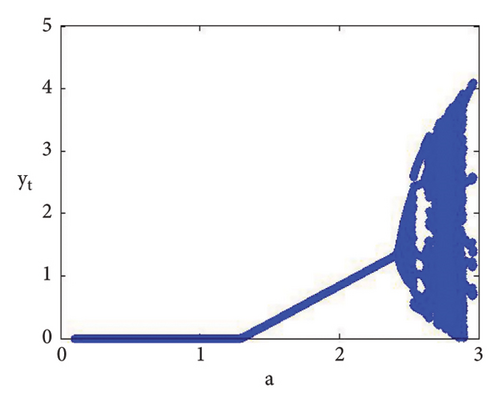
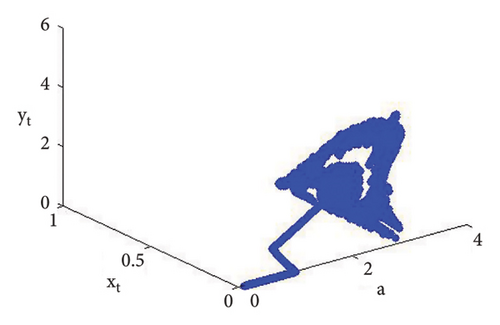
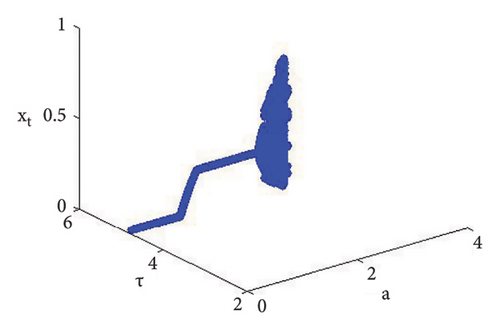
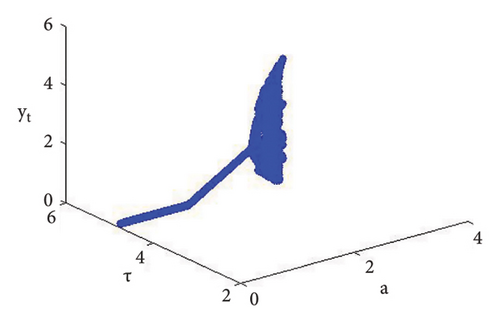
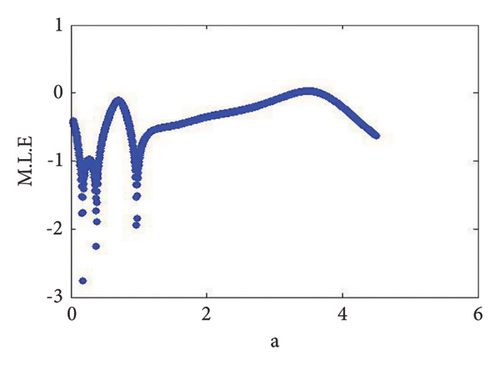
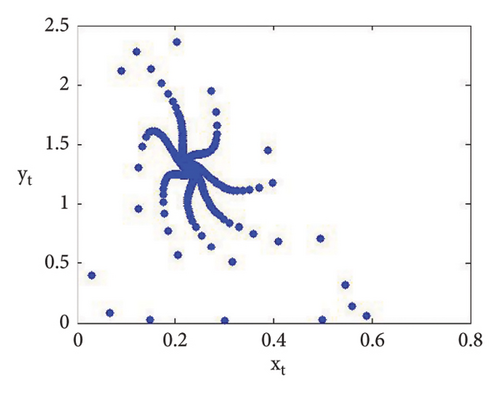
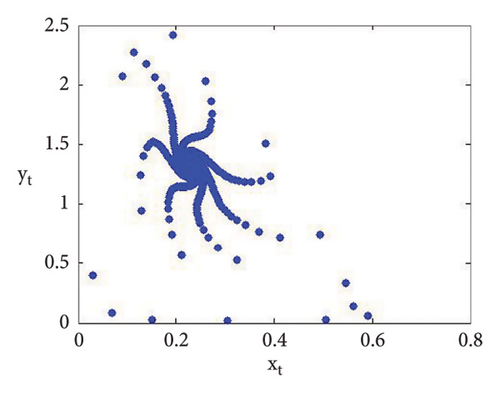
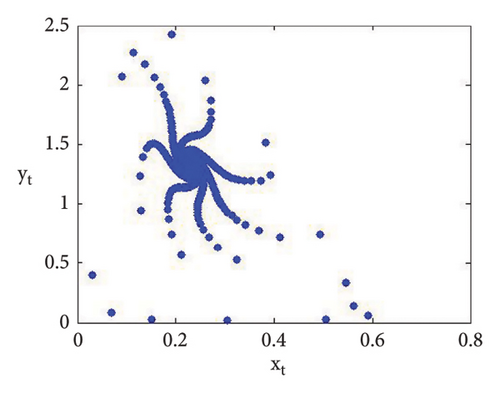
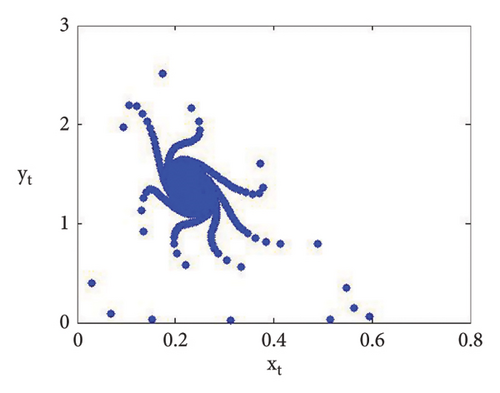
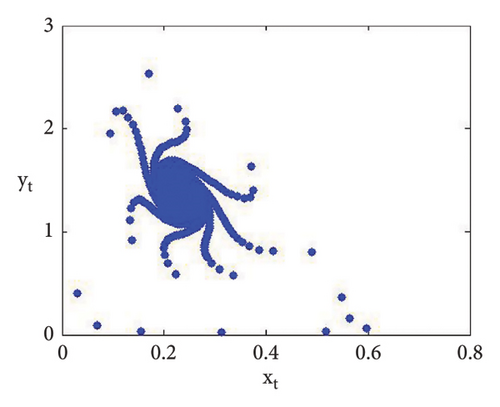
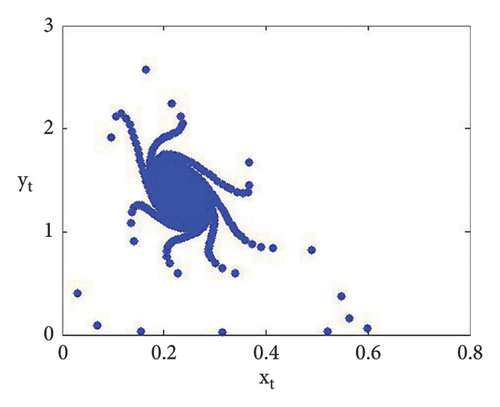
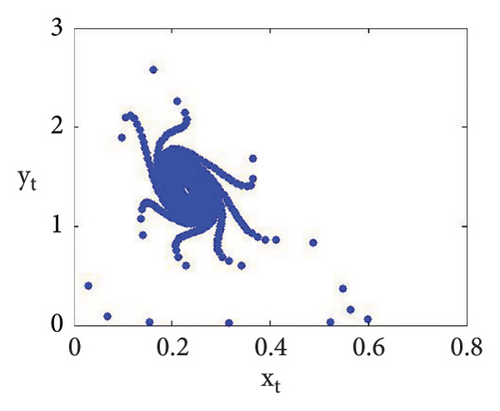
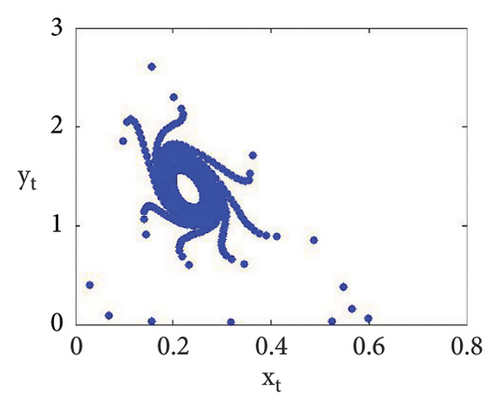
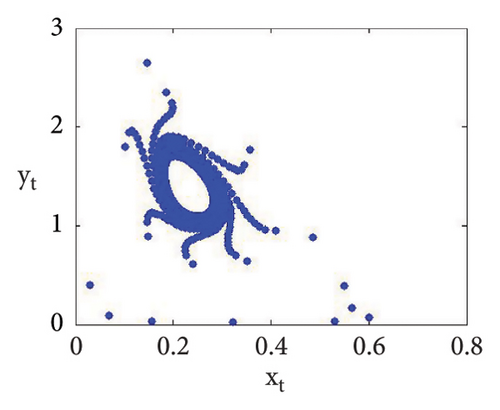
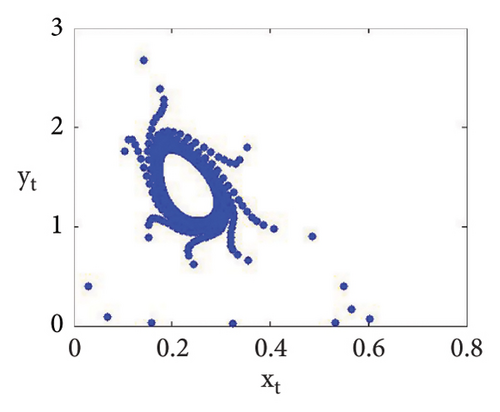
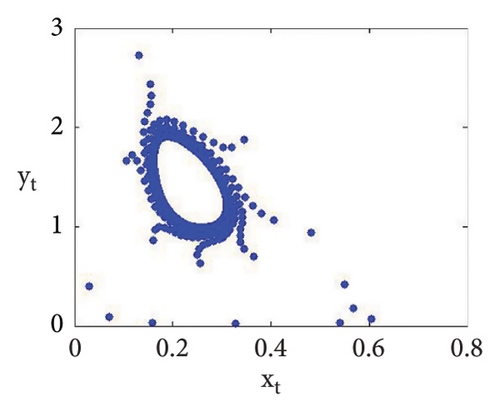
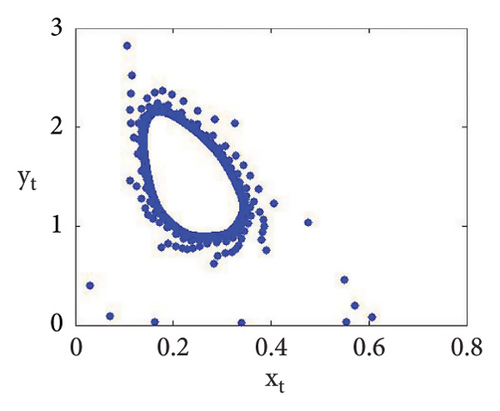
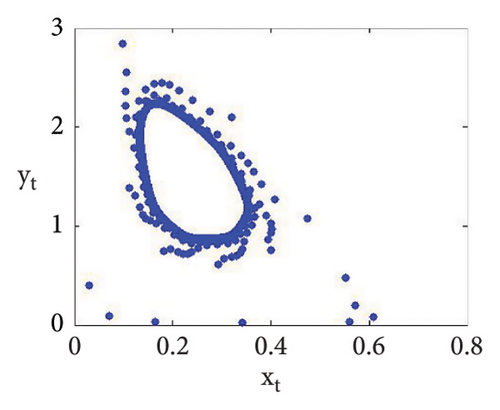
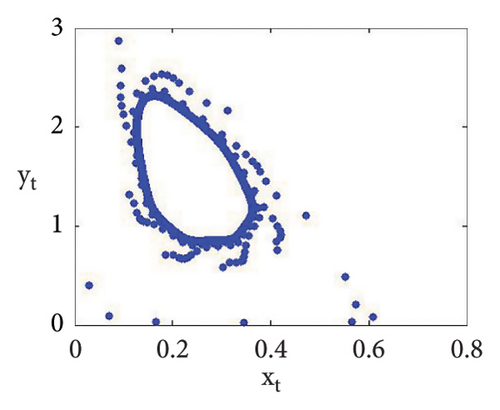
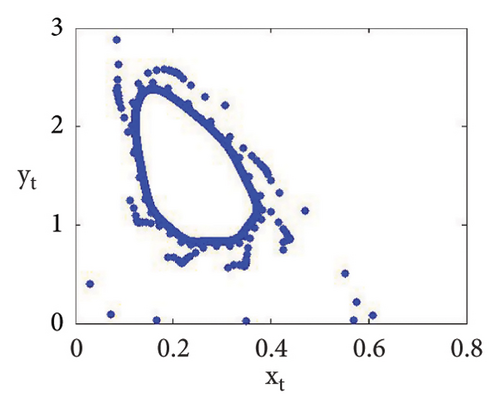
Example 2. If b = 0.6, c = 0.4 = d, e = 3.1, τ = 1.8, and a = [1.1, 4.0] with (x0, y0) = (0.2, 0.3), then flip bifurcation exists at a = 3.3084030868763388 where MLE with flip bifurcation diagrams are presented in Figure 4. Furthermore, at (b, c, d, e, τ, a) = (0.6, 0.4, 0.4, 3.1, 1.8, 3.3084030868763388), one has φ3 = (0.37037037037037035, 23.666051975387873) and moreover, from (19), one gets
Utilizing (118) into (51), one gets and . Since , and so stable period-2 points bifurcate from φ3 = (0.37037037037037035, 23.666051975387873). Therefore, in conclusion, we can say that numerical simulations in Example 2 agree with theoretical results obtained in Theorem 9(ii) of Theorems 10 and 13.
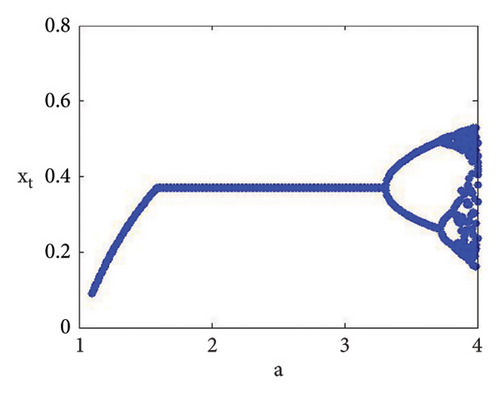
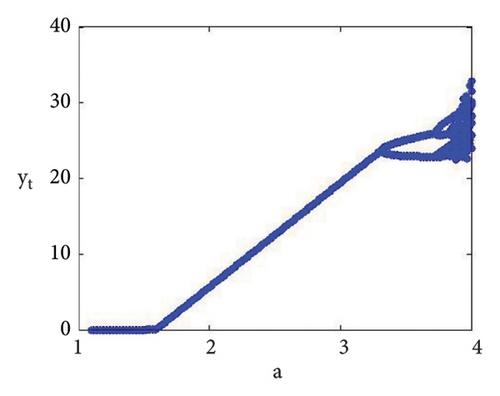
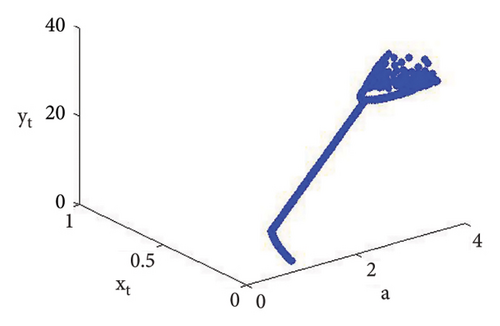
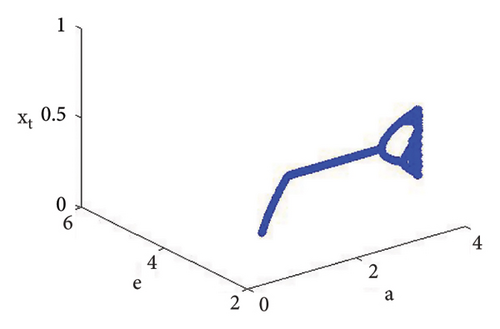
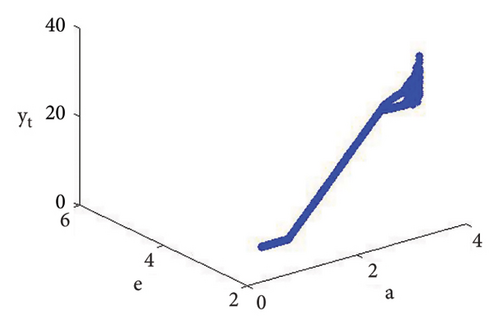
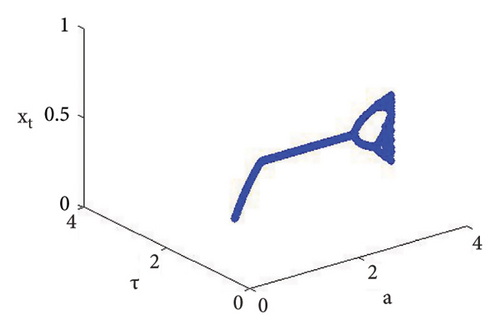
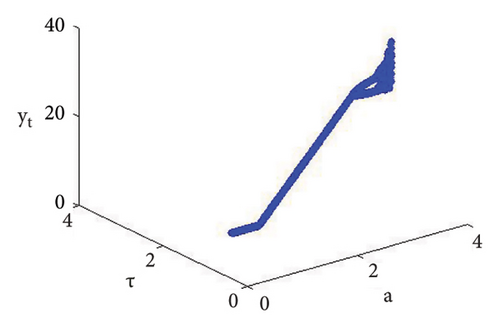

Example 3. If d = 1.9, b = 2.5, τ = 10.98, and c = 0.99, then from (56) the calculation yields e = 0.04460034922732295 and a = 5.228990586133444. Therefore, if (d, b, τ, c, e, a) = (1.9, 2.5, 10.98, 0.99, 0.04460034922732295, 5.228990586133444), then model (7) has φ3 = (0.0360655737704918, 2.706457459921495) and moreover, from (20), one gets
Using (120) into (85), one gets C = −223.52473751174273 ≠ 0 and D = 24628.549545279584 ≠ 0, D + 3 = 2.46 × 104 ≠ 0. This indicates that codimension-two bifurcation with 1 : 2 strong resonance bifurcation exists, which is depicted in Figure 5.
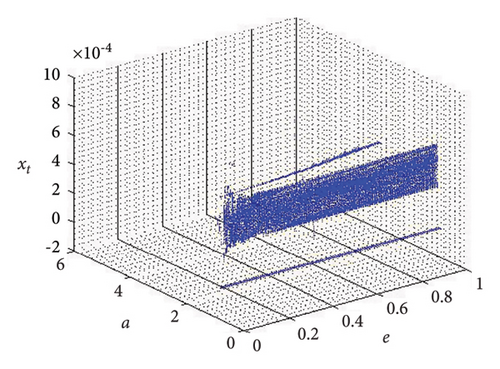

Example 4. Here, bifurcation parameter a is chosen as a controlled parameter, and so reconsider the data (d, b, c, e, τ, a) = (0.4, 0.8, 0.9, 0.09, 4.9, 2.433366930993503) as in Example 1; the MLE with bifurcation diagrams are same as in Figure 1. In order to apply the OGY control method for model (7), if a0 = 3.99, then it has equilibrium φ2 = (0.22959183673469383, 3.2228426749271137). So, model (97) becomes
Now, for marginal stability lines L1, L2, and L3 are
So, lines (123)–(125) experience the region where |λ1,2| < 1 (see Figure 6).
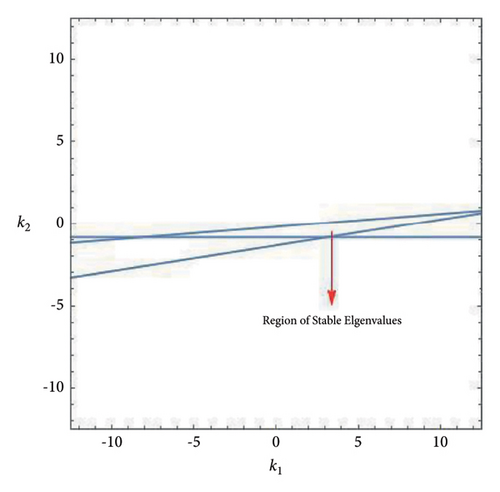
Example 5. Finally, if b = 0.6, c = 0.4 = d, e = 3.1, τ = 1.8, a = 3.3084030868763388 with (x0, y0) = (0.98, 0.5), then model (7) undergoes flip bifurcation. For this, by applying the hybrid strategy to get stable orbit at φ3 = (0.37037037037037035, 23.666051975387873). For this model, (105) takes the form
Furthermore, roots of (128) satisfy |λ1,2| < 1 if 0 < α < 1. So, for the allowed interval of control parameter α the flip bifurcation is completely eliminated. If α = 0.999, then for controlled model (126), plots of t vs. xt and yt are drawn in Figure 7.
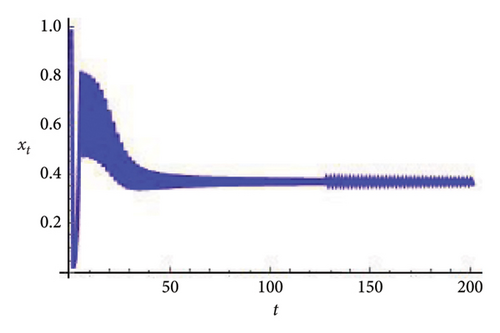
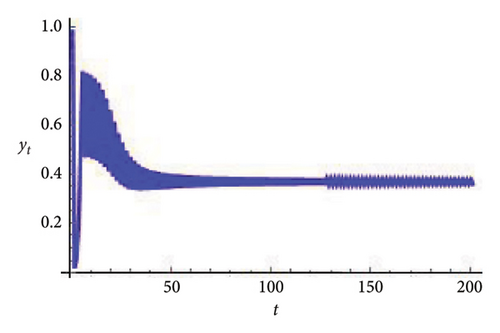
Remark 18. The convergence speed of a prey-predator model, depicting the dynamic interactions between predator and prey populations, is subject to various parameters (influential factors). Foremost among these factors are the interaction parameters that govern the dynamics of predation, reproduction, and efficiency in capturing prey. Fine-tuning these parameters can significantly impact the speed at which the model converges to a stable solution. In addition, the initial conditions set for the simulation play a critical role and carefully chosen distributions and densities of prey and predators can contribute to faster convergence, reflecting realistic ecological scenarios. Maintaining a delicate balance between prey and predator populations is crucial for efficient convergence. Extreme imbalances may impede the model’s ability to reach a stable equilibrium, affecting the overall convergence speed. Environmental factors, such as resource availability and habitat quality, further influence the dynamics and, consequently, the speed at which the model converges. The complexity of the mathematical model itself, including its level of sophistication or simplicity, can also impact convergence speed. Considerations such as the choice of numerical methods, the size of time steps, and the presence of adaptation mechanisms add additional layers of complexity that can either expedite or hinder the convergence process. In summary, a comprehensive understanding and strategic adjustment of these factors are essential for optimizing the convergence speed of a prey-predator model, ensuring a more accurate and insightful representation of ecological dynamics. Our results underscore the intricate interplay of factors affecting the convergence speed in the prey-predator model. The observed sensitivity to parameter values and initial conditions emphasizes the need for a nuanced approach in calibrating the model for accurate and efficient simulations. Through this iterative process of parameter exploration and adjustment, a deeper understanding of the dynamics and equilibrium states in the simulated ecosystem has been achieved.
Remark 19. The connection between the bifurcation diagram and the MLE diagram is important to understanding the dynamic behavior of nonlinear systems. The bifurcation diagram represents transitions between stable and chaotic states by graphically representing the qualitative changes in a system as a parameter is varied. In addition, the MLE serves as a quantitative measure of the system’s sensitivity to initial conditions, particularly in chaotic regimes. Bifurcation region associated with transitions to chaos often align with peaks in the MLE diagram, indicating high rates of divergence in trajectories. Together, these diagrams provide complementary insights into the stability and predictability of a dynamic system. The bifurcation diagram offers a visual representation of the system’s behavior, while the MLE quantifies the degree of chaos, allowing for a more comprehensive understanding of the intricate dynamics governing nonlinear systems. MLE can help to resolve some of these ambiguities by quantifying the degree of chaos in a system. MLE is defined as the average exponential rate of divergence (or convergence) of two nearby trajectories in the phase space of a system. A positive MLE indicates that the system is chaotic, since small perturbations will grow exponentially over time. A negative MLE indicates that the system is stable since nearby trajectories will converge to a fixed point or a periodic orbit. A zero MLE indicates that the system is marginally stable since nearby trajectories neither diverges nor converges.
7. Preservation of the Positivity
On performing straightforward computation by Mathematica, one obtain that F1(Δ) = Δ, if α ∈ (0, 4), b < 1, c ∈ (0, 1) and τ ≤ 6.8 where Figure 8(a) shows the positive nature of model (7). On contrary, Figure 8(b) shows the negative behavior of the discrete prey-predator model (7) if α > 4, b = 1, c = 1.1 and τ = 6.9.

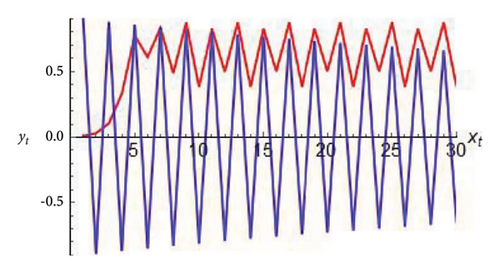
8. Conclusion
The work is about local dynamics, chaos, and codimension-one and codimension-two bifurcations of a discrete prey-predator model (7). It is proven that model (7) has trivial, semitrivial, and interior fixed points algebraically. We have studied local dynamics at fixed points by the linear stability theory. In order to study the bifurcation analysis at equilibria, we first identified codimension-one bifurcation sets for the understudied model and then it proved that at the semitrivial fixed point, the model (7) undergoes flip bifurcation. Furthermore, at the interior fixed point, we have examined that model (7) undergoes Neimark–Sacker and flip bifurcations if parameter goes through the certain curves, and at this point, we also studied codimension-two 1 : 2 strong resonance bifurcation analysis. Next, OGY and hybrid control strategies are employed to manage chaos in the model under study, which arises from Neimark–Sacker and flip bifurcations, respectively. We have examined the preservation of the positive solution of the discrete prey-predator model (7). Finally, numerical simulations are given to verify the theoretical results. Our numerical simulations reveal that at the interior fixed point, model (7) undergoes supercritical Neimark–Sacker, which implies that there exist quasiperiodic or periodic oscillations between prey and predator individuals.
In our exploration, we delved into the dynamics of a prey-predator model by employing linear stability theory, a well-established method in existing literature for studying bifurcations. The model (7)’s interior fixed point became a focal point of our investigation, revealing significant insights into its behavior, particularly through the identification of Neimark–Sacker (N-S) and flip bifurcations. The recognition of these bifurcations enhances our understanding of how the prey and predator populations undergo qualitative changes, introducing a layer of complexity to their interactions. In addition, we extended our study to chaos control within the prey-predator model. Chaos control strategies were implemented to navigate and regulate the system’s behavior, providing a means to influence and stabilize the dynamics, especially in the context of the recognized N-S and flip bifurcations. The application of chaos control techniques adds a practical dimension to our research, offering potential tools for managing and steering the prey-predator system towards more predictable and stable states. By combining insights from the linear stability theory, bifurcation analysis, and chaos control strategies, our study contributes to the comprehensive understanding of the prey-predator model’s behavior. This knowledge not only enriches the existing literature on ecological dynamics but also provides practical implications for ecosystem management and conservation efforts, showcasing the interdisciplinary nature of our research approach.
8.1. Future Direction
The study of codimension-two 1 : 3 and 1 : 4 strong resonance bifurcation analysis and global dynamics of the discrete model (7) is our next aim to study.
8.1.1. Expression for the Coefficients Quantities of System (35)
8.1.2. Expression for the Coefficients Quantities of System (38)
8.1.3. Expression for the Coefficients Quantities of System (42)
Conflicts of Interest
The authors declare that they have no conflicts of interest.
Acknowledgments
This study was supported via funding from Prince Sattam bin Abdulaziz University (project number PSAU/2024/R/1445).
Open Research
Data Availability
No data were used to support the findings of this study.




